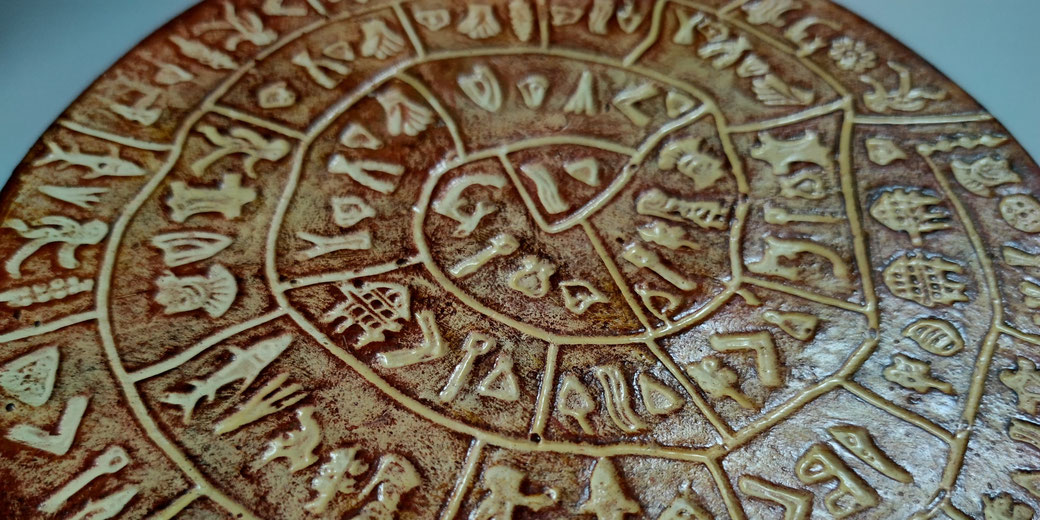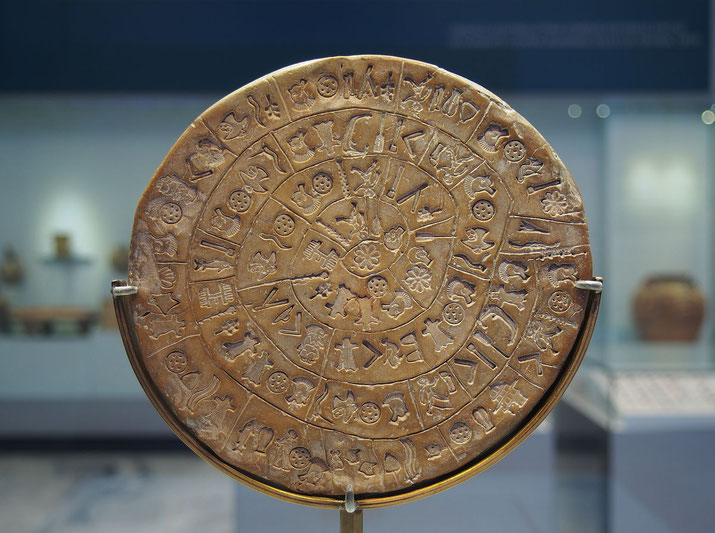The Phaistos Disc: one of the greatest unsolved mysteries of the ancient world

Imagine discovering an object that has remained shrouded in mystery for over a century. An object so unique that no other like it has ever been found, and so cryptic that even the most brilliant minds in archaeology and linguistics have been unable to decipher its meaning.
Such an object actually does exist, and it is known as the Phaistos Disc. This round, clay object was unearthed on the Greek island of Crete in 1908, and its symbols have baffled scholars ever since.
Despite numerous attempts over the years to unlock its secrets, the Phaistos Disc remains one of the most enigmatic and fascinating artifacts from the ancient world.
Here is everything we know about this mysterious object.
What is the Phaistos Disc?
The Phaistos Disc is a round, clay object approximately 15 centimeters in diameter that was discovered on the Greek island of Crete in 1908.
The object is inscribed with a series of symbols that have yet to be fully deciphered, making it one of the most intriguing and mysterious artifacts in the history of archaeology.
The disc was found by Italian archaeologist Luigi Pernier during excavations at the Minoan palace of Phaistos, in the modern Faistos region of Crete, which was built during the Bronze Age, around 1700 BC.
The disc is believed to have been created during this period, although its purpose and meaning remain unknown.
What is on the Phaistos Disc?
The Phaistos Disc is inscribed with a series of symbols arranged in a spiral pattern on both sides of the disc.
There are a total of 241 characters in all, consisting of 45 unique signs. The symbols are believed to have been impressed onto the disc using a stamp, rather than being hand-drawn.
The symbols themselves are relatively simple, and many of them resemble hieroglyphics or other ancient writing systems.
The symbols on the Phaistos Disc have been compared to various other ancient writing systems, including Linear A and Linear B, which were used by the Minoans and Mycenaeans respectively.
Some of the symbols also resemble hieroglyphics from ancient Egypt, as well as various symbols used in ancient Near Eastern writing systems.
However, there is no consensus among scholars as to the origin or meaning of the symbols on the Phaistos Disc
The mysteries surrounding the artefact
The greatest mystery surrounding the Phaistos Disc is undoubtedly its purpose and meaning.
Despite numerous attempts by scholars over the years to decipher the symbols on the disc, no one has been able to definitively determine what they represent.
The symbols themselves are relatively simple and resemble various other ancient writing systems, but there is no known language that matches the pattern of symbols on the disc.
Additionally, there are no other objects like it known to exist, and no other examples of Minoan writing in a circular or spiral format.
This has led to a number of theories and speculations about the disc's purpose, ranging from it being a form of writing or a religious or mystical object with symbolic meaning, to it being a forgery or a hoax.
This has led some scholars to suggest that the disc may have been a one-of-a-kind object, created for a specific purpose or ceremony.

Those who have claimed to be able to read it
There have been a number of claims over the years of people having translated the text on the Phaistos Disc, but none of these claims have been widely accepted by the academic community.
In fact, the vast majority of scholars believe that the symbols on the disc remain undeciphered, and that any attempts to translate them are purely speculative.
Some of the more famous attempts to translate the text include those by the archaeologist Luigi Pernier, who discovered the disc in 1908, and the linguist Gareth Owens, who proposed a partial translation in 2014.
However, none of these attempts have been able to withstand scholarly scrutiny.
What was the Phaistos Disc made for?
There are a number of theories and speculations about the purpose of the Phaistos Disc.
One theory is that it was a form of writing, possibly representing an unknown language or dialect of the Minoan civilization.
Another theory is that the disc was a religious or mystical object with symbolic meaning, possibly representing a creation myth or some other important aspect of Minoan culture.
Some scholars have suggested that the disc was a form of accounting or a calendar, while others have proposed that it was a toy or a game.
Is it fake?
There is no evidence to suggest that the Phaistos Disc was a forgery, and the vast majority of scholars believe that it is an authentic artifact from the Minoan civilization.
Luigi Pernier, the archaeologist who discovered the disc in 1908, was a respected and reputable scholar, and there is no reason to believe that he would have created a forgery.
In addition, the disc has been extensively analyzed and studied by experts in a variety of fields, including archaeology, linguistics, and metallurgy, and there is no evidence to suggest that it is anything other than an authentic object from the Bronze Age.
Who will finally find the answer?
Despite the mystery surrounding the disc, it remains one of the most studied and analyzed objects in the field of archaeology.
Scholars from around the world continue to study the symbols and search for clues that might shed light on the purpose and meaning of the disc.
Although its true meaning may never be fully understood, the Phaistos Disc remains a fascinating and mysterious artifact from the ancient world.
What do you need help with?
Download ready-to-use digital learning resources
Copyright © History Skills 2014-2024.
Contact via email
With the exception of links to external sites, some historical sources and extracts from specific publications, all content on this website is copyrighted by History Skills. This content may not be copied, republished or redistributed without written permission from the website creator. Please use the Contact page to obtain relevant permission.





